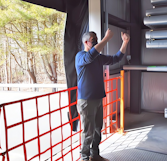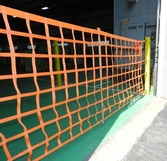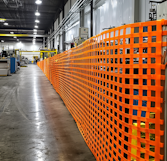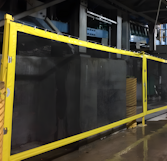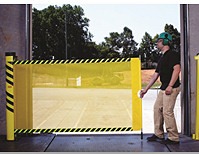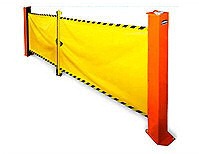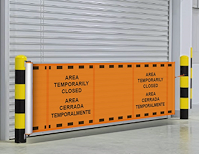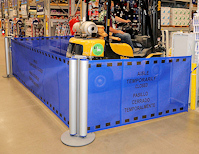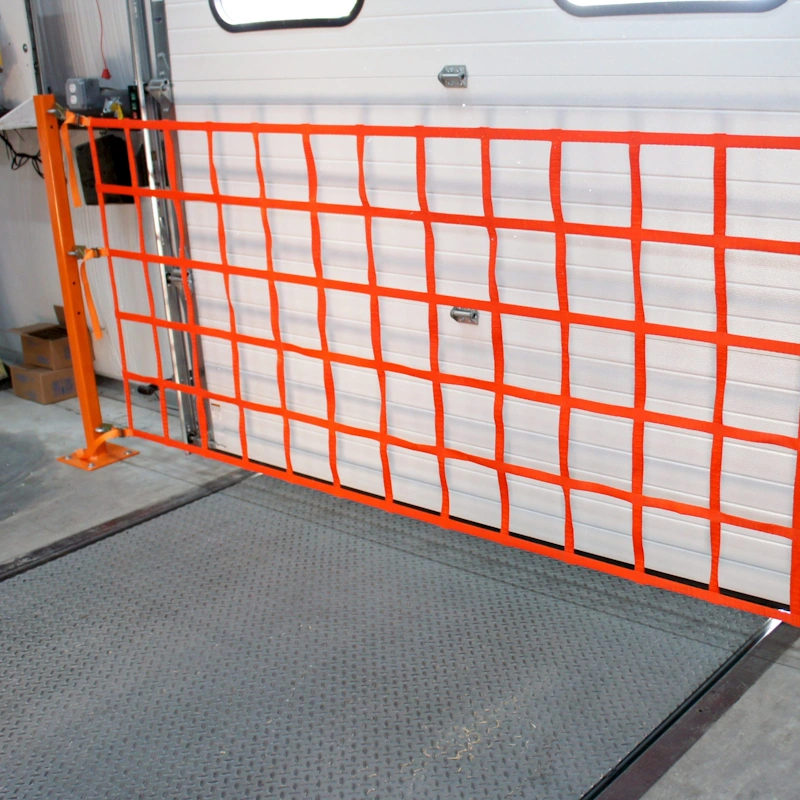Dock Barrier -- Load Bearing
Netting Safety Barriers
Dock Barrier -- Visual
Common Questions
Are Dock Barriers Even Required?
First off, it's important to remember that, in 2014, OSHA listed the following ten safety infractions as the most frequent:
- #1 was fall safety (OSHA 1926.50)
- #5 was forklift or powered industrial trucks (OSHA 1910.178)
- According to Grainger Technical Resources: "The majority of all regulations for the loading dock environment are actually directed to the operation and design of forklifts used on loading docks"
Per OSHA regulations in regards to Forklifts,1910.178(m)(6): “A safe distance shall be maintained from the edge of ramps or platforms while on any elevated dock, or platform or freight car.” Loading dock safety nets serve as a physical barrier that extends beyond the loading dock or ramp edge, often preventing or slowing down forklifts, in addition to visually designating a safe distance away from it.
Per the OSHA entry: OSHA 29 CFR 1910.23 “Guarding floor and wall openings and holes” requires fall protection from elevations of 4 feet in general industry workplaces. These hazard areas must be guarded by "rail, roller, picket fence, half-door, or equivalent barrier". The dock netting satisfies the 42-inch height requirement for these barriers and, when put correctly, has a multi-directional 300-pound load resistance on the top rail, side points of the screen, and anchoring points.
What Are the Advantages of Retractable Dock Barriers?
Unlike other barriers, our nets are flexible, which makes it very simple to put them away. They may be detached from one end and moved to the other to be neatly hooked until they are needed again. Our roll-ups, which are visual-only barriers, are less expensive than physical steel barriers and are also quicker to retract and deploy. Retractable net barriers for dock openings are also generally less expensive. Starting at a sale price of $905.00.
Why Dock Barriers Are Important
In order to maintain productivity and safety in warehouses, dock barriers are essential. By preventing falls from loading docks and shielding employees from machinery, they reduce the risk of accidents. By keeping out unwanted access and protecting merchandise from theft, these barriers also improve security. Dock barriers simplify loading and unloading procedures, increase organization, and cut down on downtime by establishing limits and guiding traffic flow. They also protect items from damage by shielding operations from weather conditions like wind and rain. In general, dock barriers are necessary to keep a warehouse environment that is efficient, safe, and secure.
How are Dock Safety Nets and Retractable Dock Barriers Better Than Steel?
After installation, loading dock nets require little to no maintenance. In contrast to conventional metal forklift barriers, cross arms, or chains, the nets can bend when struck, absorbing and dispersing stress throughout the net. This typically indicates that the network system won't be harmed by modest impacts. Please keep in mind, the dock safety nets or visual barriers, should be evaluated for damage in accordance with your internal safety standards and especially following collisions. There's no need for costly on-site maintenance or repair services. It's as easy as that: just replace or repair the components as necessary.
Visual Dock Barricades Vs. Restraint Dock Barricades
In warehouses, the functions of restraint dock barricades and visual dock barricades differ. Visual dock barricades serve as visual indicators to notify workers of a dock's edge, improving awareness and minimizing unintentional falls. Examples of these barricades include safety chains and brightly colored tape. They offer little physical protection, but they are inexpensive and simple to install.
Restraint dock barricades, on the other hand, provide a physical barrier to stop falls or equipment from rolling off the dock. Examples of these barriers include safety nets and retractable gates. Because they physically halt movement, they offer stronger protection and are therefore appropriate for high-risk regions with heavy equipment traffic.

